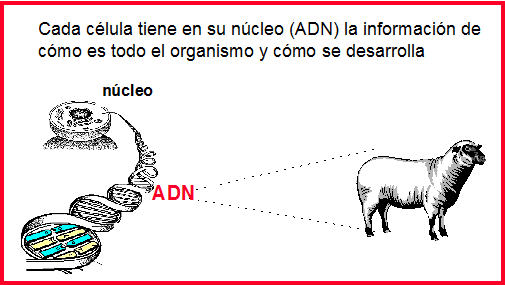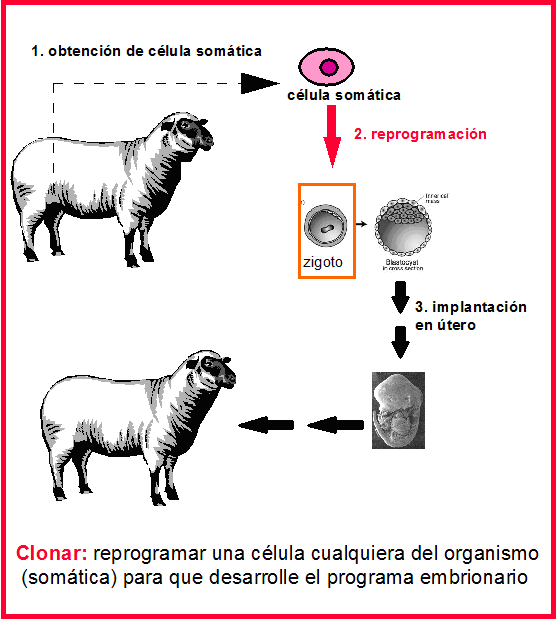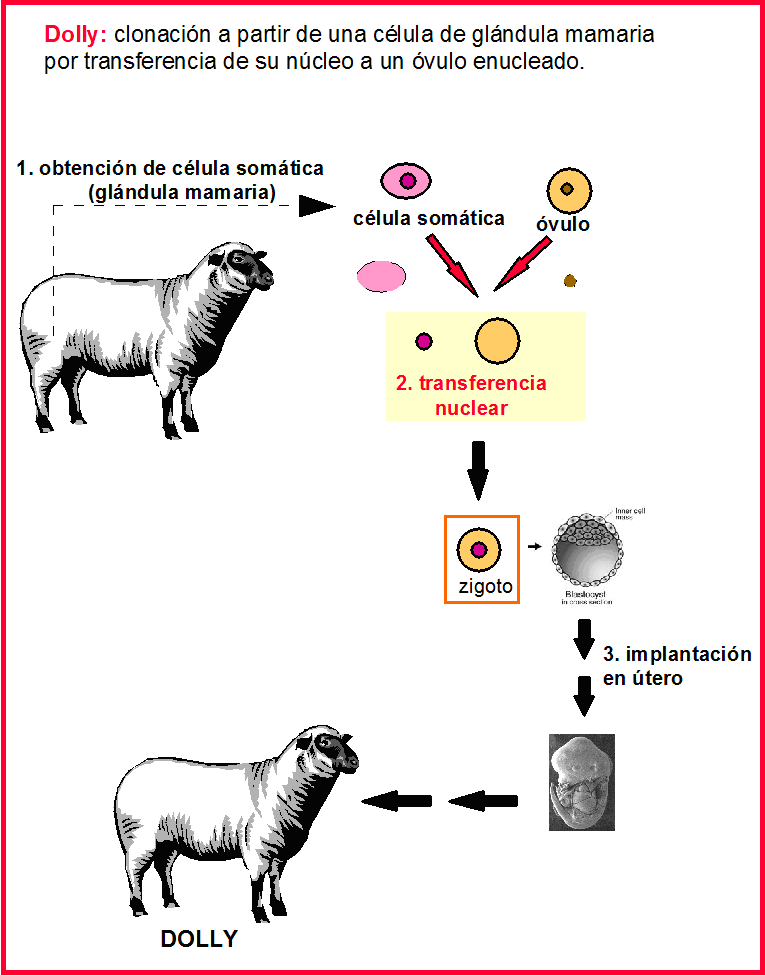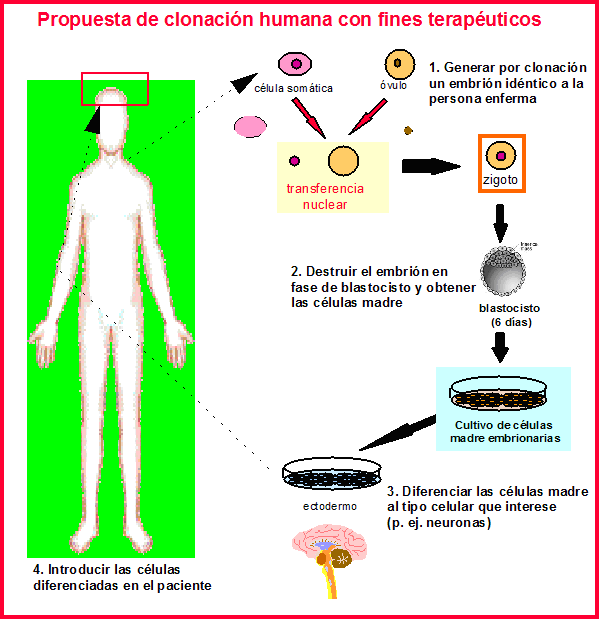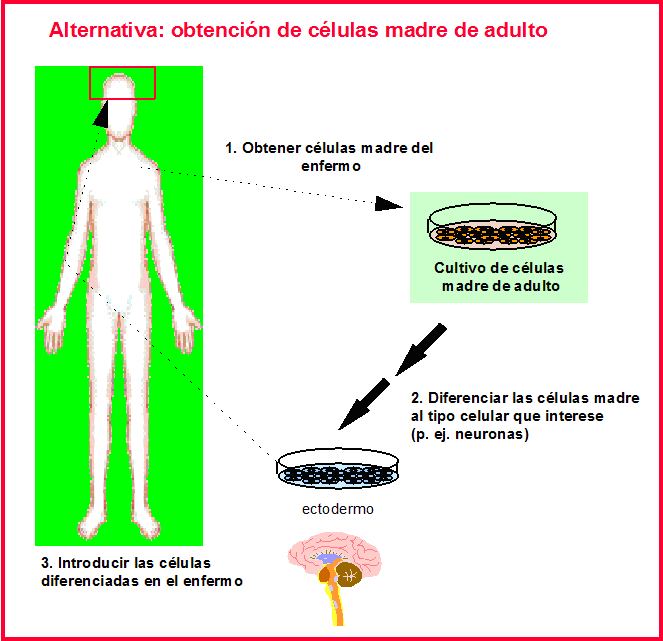On cloning
Author: María Iraburu
Lecture given in Pamplona, on 29 August 2006, in the refresher course for academic staff "Science, Reason and Faith" organised by the Higher Institute of Religious Sciences of the University of Navarra.
Text updated in May 2013.
Index
What is cloning?
Cloning can be defined as the process by which identical copies of an already developed organism are obtained in a sexual form. These two characteristics are important:
-
The starting point is an already developed animal, because cloning responds to an interest in obtaining copies of a certain animal that interests us, and only when it is an adult do we know its characteristics.
-
On the other hand, it is a matter of asexual reproduction. Sexual reproduction does not allow us to obtain identical copies, as this reproduction subject by its very nature generates diversity.
Why is cloning possible?
The possibility of cloning arose with the finding of DNA and the knowledge of how genetic information is transmitted and expressed in living beings.
To understand this better, it is necessary to briefly recall how a living being is "made". A given animal is made up of millions of cells, which are like the bricks that form the building that is the living being. These cells have very different aspects and functions. However, they all have one thing in common: in their nuclei are long chains that contain the precise information about how the organism is and how it is organised: DNA. Each cell contains all the information about how the organism of which it is a part is and how it develops.
This is for a very simple reason: all the cells of an individual derive from an initial cell, the single-cell embryo or zygote. This peculiar cell, which is already a new life, is obtained naturally by the fusion of the reproductive cells, egg and sperm, each of which contributes half of the genetic material (half of the blueprints). In the zygote we already have the information about what the new organism will be like: its sex, its physical characteristics, everything: the complete blueprints. From that moment on, this information will rapidly become reality through two processes: cell division and cell specialisation.
-
The zygote begins by dividing into cells, which in turn divide again. This is how the embryo grows: first it consists of a single cell, which divides into two, and then into 4, 8, 16, etc. At each division, a copy of the DNA present at the beginning is made (photocopies of the blueprints), so that each cell has the information of what the whole individual is like. Millions of divisions later, we will have a developed organism composed of millions of cells that all have all the information, the same as that contained in the zygote.
-
As the number of cells increases, they become more specialised and acquire different functions. In the first stages of the embryo's life, the cells that constitute it do not have specific characteristics, they are not very specialised, but for this very reason they have a lot of potential: they are capable of transforming themselves into any cellular subject , or even - in the first stages - of giving rise to a new organism. In the adult organism, however, the cells already have well-defined functions and lose their potential. This specialisation, or cell differentiation, is determined by the use of DNA: each cell uses only the part of the DNA that corresponds to its function. So, although each cell has all the information, it does not use all of it, but only the part that corresponds to it.
-
A word about reproductive cells, eggs and sperm. They are an exception to what has been said so far, because their genetic material, their DNA, is not the same as that of the rest of the cells of the organism: they have half of the DNA molecules, so that when fused with those contributed by the other reproductive cell they give rise to a complete genetic endowment; and, in addition, each reproductive cell of the same organism receives a different half of the DNA characteristic of that individual. This is the origin of diversity in sexual reproduction and the reason why any embryo produced by fertilisation is an unknown: until it grows up, we will not know its characteristics.
Taking all this into account, any cell of the adult organism (somatic, non-reproductive cells) can theoretically be used to obtain a new living being with the same characteristics, as it has in its DNA the information of what that particular organism is like and how it develops. It would be a matter of taking any cell, except for reproductive cells which have an incomplete endowment, and getting this information to be expressed, put into operation and produce another being. Cloning would therefore consist of reprogramming a somatic cell to start the embryonic programme. Once it has begun its development it would be implanted in a uterus, as it is not currently possible for embryos to reach full term outside a uterus.
Furthermore, we have the appropriate technology, both for making cells live and grow outside the body, by means of so-called cell culture techniques, and for successfully implanting embryos generated in vitro, by embryo manipulation techniques.
What difficulties does it present?
However, it soon became clear that it is by no means easy to create a new being from any cell of an adult organism. Cloning, on the other hand, presented seemingly insurmountable difficulties. The cells of different types that make up the living being can live and grow in culture, but it is very difficult for them to give rise to a new individual: they merely divide and produce more specialised cells like themselves. Although they have the information on how to make the living thing, specialisation has caused them to "lose report": they only remember the part of the information they usually use, and cannot reprogram themselves and start from scratch to produce a new being. Or at least this was thought until Dolly's existence was published.
HOW DOLLY WAS MADE
Dolly was the first cloned animal, i.e. generated from a differentiated or somatic cell, without fertilisation. This cell came from a culture of cells obtained from the udder of the sheep to be cloned. As we have said before, the cells of a given tissue, when kept alive outside the body - in culture - do not spontaneously produce embryos, but more differentiated cells like them: they do not "remember" how the embryonic programme is carried out.
To get one of these cells to "recover the report" and give rise to a new being, a technique called nuclear transfer was used: the nucleus of this cell, which is the part that contains the DNA and therefore the information, was taken and fused with the cytoplasm of an egg cell from another sheep, from which the nucleus had previously been removed. An egg cell was used because it is a cell equipped for the embryonic development , and its cytoplasm (the contents surrounding the nucleus) would in a way be the appropriate environment for the nucleus of the adult cell to reprogramme. And indeed it did: that cell, once activated with signals similar to those produced by fertilisation, transformed into a single-cell embryo and began the sophisticated embryonic programme, in a manner identical to that obtained by the fusion of an egg and a sperm. After a few days of in vitro growth, the embryo was implanted into a surrogate mother and 148 days later Dolly was born, a sheep genetically identical to the original.
The process of obtaining Dolly was very expensive, and at present not much improvement has been made. Dolly was the only positive result out of 277 attempts, from which 29 embryos were obtained, many of which failed to develop and others died shortly after birth.
All in all, Dolly was a very important scientific achievement. It showed that there is more than one way to obtain new animals. On the one hand, we have natural reproduction, which is sexual and produces diversity; on the other hand, we have cloning: artificial reproduction, which is asexual and produces identical individuals.
From a technical point of view, cloned animals have also presented problems: in addition to a higher percentage of malformations, they often suffer from a syndrome that manifests itself in larger than normal size, with negative consequences for their health and development.
ANIMAL CLONING: APPLICATIONS AND ETHICAL IMPLICATIONS
What are the possible applications of animal cloning?
-
Cloning would allow us to have many identical copies of animals that are of interest to us for various reasons: for their natural characteristics (milk production, health, longevity, etc.) or for characteristics that we have introduced ourselves thanks to new genetic manipulation technologies. The last few years have seen a spectacular development of techniques that make it possible to genetically manipulate animals and plants. These are the so-called "transgenic" organisms: plants and animals whose genetic information, DNA and blueprints have been altered, generally by introducing certain genes that make them more productive. The case of Dolly is an example. The Roslin Institute sheep was part of an ambitious programme by business PPL Therapeutics to produce genetically modified animals on a large scale that would produce human proteins of therapeutic interest in their milk. The process of breeding transgenic animals is complex and results in few individuals, at least from a large-scale production point of view. Cloning would make it possible to have a large number of the most suitable animals. Another application is the possibility of having many copies of genetically modified animals so that their organs do not cause rejection when transplanted into humans (xenotransplantation).
-
Cloning would also make it possible to extend the possibilities of genetic manipulation. The cultured cells used in cloning are a very suitable material for introducing or eliminating certain genes, and the possible genetic modifications that current techniques do not allow would be greatly expanded.
-
Identical copies of certain animals would be very useful for research. In particular, it would allow us to know more precisely how genetic variability between individuals or the presence of certain mutations affects the development of certain diseases.
Alongside its undeniable advantages, animal cloning also raises ethical objections for some. The main ones concern the environmental impact of cloned animals and the very survival of the species. The diversity provided by sexual reproduction is an advantage from a biological point of view, as it means that the species as a whole will have a variety of individuals that can adapt to the diverse conditions of the environment. In fact, only the most primitive species have modes of reproduction that do not give rise to diverse individuals but to many copies identical to the progenitors, the so-called asexual modes of reproduction: twinning, bipartition, etc... This is why there is a fear that the genetic heritage of the species will be impoverished by human manipulation and that this will have irreversible consequences for the ecosystem. However, this danger does not seem inevitable, if appropriate measures are taken to respect biodiversity and natural wealth. The very complexity of cloning ensures that cloned animals would not be produced indiscriminately, but would be limited to livestock production or therapeutic purposes, and would necessarily be relatively limited in number (and would always be able to reproduce themselves sexually).
HUMAN CLONING AND ITS ETHICAL IMPLICATIONS
The publication of Dolly's existence immediately raised discussion about the possibility of cloning people. The biological proximity suggests that human cloning would be possible from a technical point of view, although there are limiting factors (mainly the number of eggs needed: it took more than 400 to obtain Dolly). The discussion, therefore, is placed in an ethical context, not on whether it is possible to carry it out, but on whether it is advisable, whether it should be approved, and if so, whether it should be approved.
There are many ethical considerations that can be made about human cloning. One approach would be to consider the purpose of cloning: whether it is to obtain a new developed being (reproductive cloning) or an embryo that will be destroyed to provide cells or tissues (human cloning for therapeutic purposes).
For reproductive purposes
There is a fairly generalised attitude among the scientific community of rejection of human cloning for reproductive purposes, if only for practical considerations: low success rate, high number of eggs required, possibility of alterations or diseases in the clones.... These objections, which focus on the negative consequences, do not seem to be sufficiently well-founded, and researchers are often heard to claim that if there were a really important reason for cloning human beings, they would see no objection to it. Arguments with an anthropological, and therefore stronger, foundation subject could be summarised as follows:
Cloning, even if it did not involve the death of embryos and if it were 100% successful in producing a flawless human being, is an attack on the person thus generated, who would suffer a manipulation that would be difficult to overcome:
-
The clone would be positively selected by others, who have decided what its genetic endowment and biological characteristics will be.
-
The clone would be generated for a purpose: to emulate someone whose characteristics are of interest for some reason: a deceased son to be replaced, a genius whose abilities are of interest to maintain, etc. The psychological consequences of this pressure would be unpredictable.
-
The clone would lack the elementary relations of a family: it would have no father at all, nor properly speaking no mother: it would have an older twin brother, an ovular (cytoplasmic?) mother and a surrogate mother.
This can be formulated positively by saying that every human being has the right to have the right to
-
No third party decides its genetic component.
-
To be loved for its own sake and not to achieve an end, such as emulating or replacing someone else (an approach that also assumes a total ignorance of what human beings are like).
-
He has a father and a mother from whom he comes, also biologically, and who are responsible for him.
In other words: reproductive cloning infringes on the freedom of the clone, fixes its biological conditions according to the criteria of others, and in this sense is an example of manipulation of man by technology (managed by third parties) that is difficult to surpass.
For "therapeutic purposes": the finding of embryonic stem cells.
In the field of therapeutic application of embryos lies the real discussion which is currently shaking public opinion and the scientific community. In order to describe in detail what these possible applications would consist of, it is necessary to refer to some recent discoveries or developments, which are not directly related to cloning. Specifically:
-
The possibility of curing diseases by carrying out transplants not with whole organs, but with cells, by means of so-called cell therapy. This seems to be a good alternative for certain diseases that are the result of the malfunctioning of a well-defined population of cells, result . It would consist of replacing diseased cells with healthy ones, without the need to transplant the entire organ.
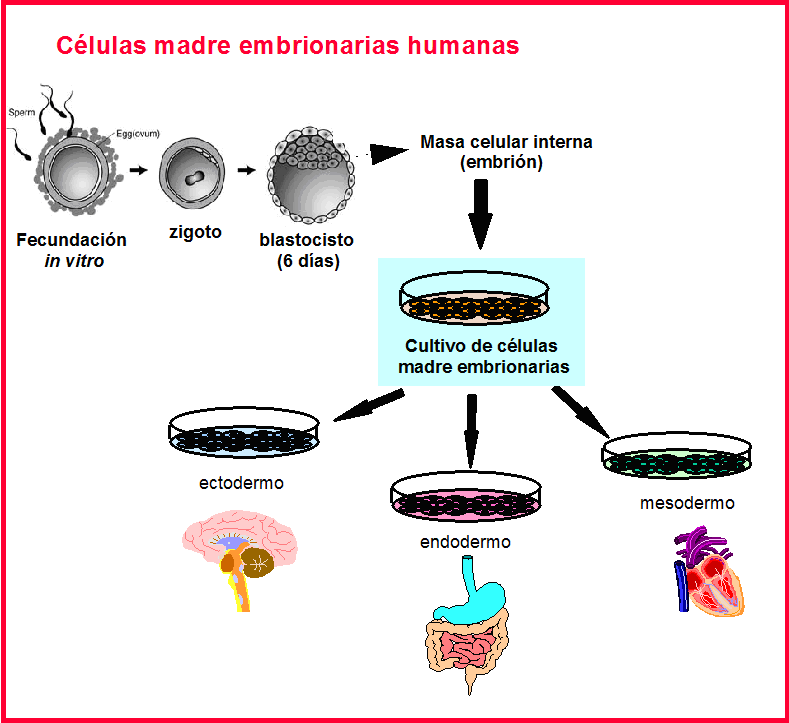
So what is proposal human cloning for therapeutic purposes? It would consist of combining the technique of cloning with that of obtaining embryonic stem cells, in order to cure adults with a disease that could be solved by cell transplantation. This would be done in the following way:
-
Using the technique employed in Dolly, an embryo would be generated from differentiated cells of the person to be cured.
-
The cloned embryo would be destroyed after 6 days in order to obtain embryonic stem cells from it.
-
These cells would specialise towards the subject cell needed to cure the person in question.
-
These cells would be implanted to cure the person.
Since the cells would come from an embryo identical to the starting person, they would not cause rejection when implanted, and the possibility of keeping cell cultures frozen would provide an almost unlimited supply of tissues source . It should be noted that from a technical point of view this process is still a mere possibility and would require a lot of research to be implemented: no well-defined cell types have yet been achieved from embryonic stem cells and there is little evidence that they can actually cure diseases.
What are the ethical implications of this procedure? In this case there is no manipulation of the new human being, as in reproductive cloning, for the simple reason that the embryo will never reach full term because it will be destroyed in order to be source of tissues. The same embryo implanted in a woman's uterus would give rise to a child, because the cloning process is identical whatever the purpose (reproductive or therapeutic). It is clear that the term "therapeutic" applied to this process is misleading: it is therapeutic for one human being, but at the cost of the life of another. The unlawfulness of this cloning subject is based on the right to life which demands the dignity of every human being, regardless of his or her Degree from development. No one has the right to health at any price, especially not if the price is another human life.
SOME ALTERNATIVES TO HUMAN CLONING FOR THERAPEUTIC PURPOSES
There are alternatives to human cloning for therapeutic purposes that do not present such serious ethical objections. The most interesting is the possibility of obtaining stem cells of non-embryonic origin.
-
In the human body there are adult stem cells that are precursors of other cell types: less specialised cells that could give rise to various cell types. In recent years it has been discovered that these cells are much more versatile than previously thought. If put into culture and treated with various factors, they can be made to differentiate into cell types very different from those they normally give rise to in the body. In adults, stem cells are found in bone marrow, the nervous system and various organs.
Using these cells for self-transplantation would not present any ethical problems, as there would be no new life involved.
-
Induced pluripotent stem cells or iPS cells. The work of Dr. Yamanaka (award Nobel Prize in Physiology 2012) has shown that a somatic cell can be reprogrammed to acquire the characteristics of a dedifferentiated cell. This is achieved by artificially enhancing, through genetic manipulation, the expression of several genes that are like "marks" of cellular dedifferentiation.
At final: there are therapeutic avenues that are being made possible by the development of science and that do not violate the respect due to human life at all stages of its development development. It is everyone's duty to defend human life and to encourage the channelling of research efforts towards this subject of techniques.

